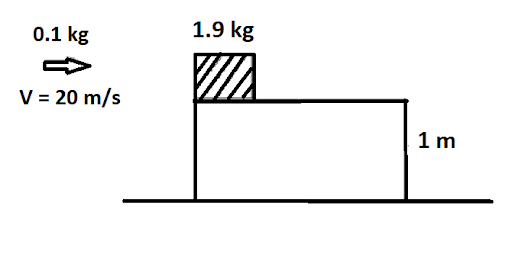
A block of mass 1.9 kg is at rest at the edge of a table, of height 1 m. A bullet of mass 0.1 kg collides with the block and sticks to it. If the velocity of the bullet is 20 m/s in the horizontal direction just before the collision then the kinetic energy just before the combined system strikes the floor is (Take g = 10 m/\[{s^2}\]. Assume there is no rotational motion and loss of energy after the collision is negligible.)
A. 23 J
B. 21 J
C. 20 J
D. 19 J
Answer
217.5k+ views
Hint: When bullets get stuck to block, then total mass becomes the sum of both the mass of the block and the mass of the bullet. As a system there is no external force acting on it so momentum will be conserved. By using the conservation of linear momentum we can determine the velocity.
Formula used:
Linear momentum is given as,
\[p{\rm{ = m}} \times {\rm{v}}\]
Where $m$ is mass and $v$ is velocity of an object.
Work energy theorem is given as,
\[{W_{net}} = {K_f} - {K_i}\]
Where \[{W_{net}}\] is net work done, \[{K_f}\] is final kinetic energy and \[{K_i}\] is Initial kinetic energy.
Complete step by step solution:
Mass of a block, \[{m_1}\]= 1.9 kg
Height of a table, h= 1 m
Mass of a bullet, \[{m_2}\]= 0.1 kg
Velocity of the bullet is in the horizontal direction, v=20 m/s
Take g = 10 m/\[{s^2}\]

Image: A block is at rest at the edge of a table, of height 1 m and a bullet collides with the block and sticks to it.
As we know that momentum,
\[p = \text{mass} \times \text{velocity}\\
\Rightarrow p = m \times v\]
When bullets get stuck to the block, then total mass becomes \[{m_1} + {m_2} = 1.9 + 0.1 = 2{\rm{ kg}}\].
As system here no external force acting on it so momentum is conserved,
Initial momentum, \[{p_i}\]= Final momentum, \[{p_f}\]
Substituting the values,
\[0.1 \times 20 + 1.9 \times 0 = 2 \times v\]
Thus, the combined velocity is \[v = \dfrac{2}{2} = 1{\rm{ m/s}}\]
Let the final kinetic energy be K.
As work done due to gravity can be mgh=\[mg \times 1\]
Now by work energy theorem,
\[2 \times 10 \times 1 = K - \dfrac{1}{2} \times 2 \times {1^2}\]
\[\therefore K = 21{\rm{ J}}\]
Therefore, the kinetic energy at ground floor is \[K = 21{\rm{ J}}\].
Hence option B is the correct answer
Note: The work-energy theorem is defined as the net work done is equal to the change in kinetic energy. This theorem only applies to the network, not the work done by any single force. Also, the area under force and position graph gives the net work done.
Formula used:
Linear momentum is given as,
\[p{\rm{ = m}} \times {\rm{v}}\]
Where $m$ is mass and $v$ is velocity of an object.
Work energy theorem is given as,
\[{W_{net}} = {K_f} - {K_i}\]
Where \[{W_{net}}\] is net work done, \[{K_f}\] is final kinetic energy and \[{K_i}\] is Initial kinetic energy.
Complete step by step solution:
Mass of a block, \[{m_1}\]= 1.9 kg
Height of a table, h= 1 m
Mass of a bullet, \[{m_2}\]= 0.1 kg
Velocity of the bullet is in the horizontal direction, v=20 m/s
Take g = 10 m/\[{s^2}\]

Image: A block is at rest at the edge of a table, of height 1 m and a bullet collides with the block and sticks to it.
As we know that momentum,
\[p = \text{mass} \times \text{velocity}\\
\Rightarrow p = m \times v\]
When bullets get stuck to the block, then total mass becomes \[{m_1} + {m_2} = 1.9 + 0.1 = 2{\rm{ kg}}\].
As system here no external force acting on it so momentum is conserved,
Initial momentum, \[{p_i}\]= Final momentum, \[{p_f}\]
Substituting the values,
\[0.1 \times 20 + 1.9 \times 0 = 2 \times v\]
Thus, the combined velocity is \[v = \dfrac{2}{2} = 1{\rm{ m/s}}\]
Let the final kinetic energy be K.
As work done due to gravity can be mgh=\[mg \times 1\]
Now by work energy theorem,
\[2 \times 10 \times 1 = K - \dfrac{1}{2} \times 2 \times {1^2}\]
\[\therefore K = 21{\rm{ J}}\]
Therefore, the kinetic energy at ground floor is \[K = 21{\rm{ J}}\].
Hence option B is the correct answer
Note: The work-energy theorem is defined as the net work done is equal to the change in kinetic energy. This theorem only applies to the network, not the work done by any single force. Also, the area under force and position graph gives the net work done.
Recently Updated Pages
Addition of Three Vectors: Methods & Examples

Addition of Vectors: Simple Guide for Students

Algebra Made Easy: Step-by-Step Guide for Students

Relations and Functions: Complete Guide for Students

Analytical Method of Vector Addition Explained Simply

Arithmetic, Geometric & Harmonic Progressions Explained

Trending doubts
JEE Main 2026: Application Form Open, Exam Dates, Syllabus, Eligibility & Question Papers

Derivation of Equation of Trajectory Explained for Students

Hybridisation in Chemistry – Concept, Types & Applications

Understanding the Angle of Deviation in a Prism

Understanding Collisions: Types and Examples for Students

How to Convert a Galvanometer into an Ammeter or Voltmeter

Other Pages
JEE Advanced Marks vs Ranks 2025: Understanding Category-wise Qualifying Marks and Previous Year Cut-offs

Units And Measurements Class 11 Physics Chapter 1 CBSE Notes - 2025-26

NCERT Solutions For Class 11 Physics Chapter 8 Mechanical Properties Of Solids

Motion in a Straight Line Class 11 Physics Chapter 2 CBSE Notes - 2025-26

NCERT Solutions for Class 11 Physics Chapter 7 Gravitation 2025-26

Understanding Atomic Structure for Beginners




